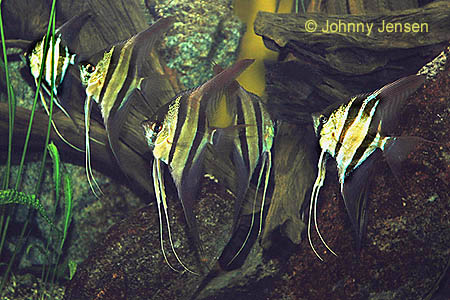Common Angelfish

Zebra Angelfish
The Common Angelfish is also known as the Scalare or Zebra Angelfish. They originally came from the Amazon Basin. Unlike the Altum, Common Freshwater Angelfish come in a wide variety of names, shapes and colors, such as Black, Gold, Zebra Striped and Marbled. The body is extremely thin and disk shaped. The anal and dorsal fins are very long and eyes are often red. Common angelfish prefer a tank of about 30 gallons. The tank should contain hiding places and hardy plants are best.
Common Angelfish - Aquarium Setup
Common Angelfish are peaceful and ignore other fish, but they can be quite territorial, especially when breeding. Angelfish prefer soft, slightly acidic water, but they will tolerate a wide range of hardness and pH. If you don't plan to breed them they should be fine with a pH as high as 8.5

Koi Angelfish
Common Angelfish - Breeding
The best way to breed angels is to start with about 8 - 10 juveniles. Look for angelfish that form pairs, as you won't be able to identify any sexual differences. Freshwater Angelfish breed on a flat vertical surface such as rock, leaves or aquarium glass. Temperatures should be at the upper end of their range. Make sure the water is soft and slightly acidic to help ensure the fry survive. Hundreds of eggs hatch in a couple of days. When the fry have finished their yolk sac, feed them brine shrimp until they are large enough for flake food. Both parents will also care for the young, but they have been known to eat a few of them too.
Common Angelfish - Compatibility:
Common Angelfish are compatible with Black Skirt Tetras, Blind Cave Tetras, Chinese Algae Eaters, Congo Tetras, Corydoras Catfish, Diamond Tetras, Gouramis, Kuhli Loaches, Lemon Tetras, Mollies, Platies, Plecostomus, Rainbowfish, Serpae Tetras, Silver Dollars, Silver Tip Tetras, Swordtails
Guppies, Neon Tetras and White Clouds are eaten by Angelfish. They often hunt smaller fish at night.
50% of our readers think that Discus are compatible with Angelfish.
Common Angelfish - Profile
-
Scientific Name: Pterophyllum Scalare
-
Family: Cichlid
-
Temperature: 24 - 30 C; 75 - 86 F
-
pH: 6.0 - 8.0
-
Size: 9 cm; 3.5 inches
-
Life Span: 15 years
-
Breeding: Normal, Egglayer
Freshwater Angelfish - Comments
Comments by Gillian: I have an angelfish and she likes flakes, freeze dried bloodworms, frozen bloodworms, and frozen mysis shrimp. And she's a total glutton and seems to be always hungry!! Many angels are like this I think, so it can be easy to overfeed them.
Altum Angelfish

Altum Angelfish
The Altum Angelfish originates from the waters of the Rio Orinoco in Venezuela. They are also known as the Deep Angel due to their height. Altums are considered one of the most beautiful freshwater angelfish, but are more difficult to keep than the Common angelfish, pterophyllum scalare. Altum Angelfish are also difficult to find in pet stores, as they are usually wild caught. Unlike the Common Angelfish, the Altum has not been bred into a variety of colors and fin variations. The Altum has vertical black stripes and a silver/brown background. There is an indentation or notching at the eyes, giving a pointed appearance to the mouth. The banding helps them hide easily among long stemmed plants. The Altum is much larger than the common angelfish and can reach 15 inches tall.
Altum Angelfish - Aquarium Setup
The tank for Altum Angelfish must be large and deep due to their size. Large, long stemmed plants are recommended to enhance the Altums vertical appearance and to provide hiding places. The water should be very soft and peat filtration is recommended. Open swimming spaces should also be provided. Although Altums are peaceful, they can also be territorial. Some open swimming spaces should be provided. The substrate should be large, smooth gravel to ensure their mouths are not cut when gravel is picked up. Temperatures in the tank are best at the higher end of their range.

Altum Angelfish
Altum Angelfish - Feeding
Altums are not a great community fish, but larger tetras may successfully be kept with them. As they are mainly obtained in the wild, live foods will be preferred. Altum Angelfish will eat live and frozen brine shrimp, granular fish food, and live and frozen blood worms.
Altum Angelfish - Black Spot Disease
Altums can develop black spot disease, which produces small black spots over their body. It can be treated with Black Spot Control from Aquatronics. Avoid using copper sulfate for any Altum disease.
Altum Angelfish - Breeding
Breeding Altums will be difficult. Pairs can be determined by observing behaviour of larger groups. Soft water will be essential. Parents will guard their young, but other fish should not be present in the breeding tank.
Altum Angelfish - Compatibility:
Altum Angelfish are compatible with Other Angelfish, Corydoras, Gouramis, Plecos, large Tetras
Guppies and Neon Tetras are eaten by Angelfish.
50% of our readers indicate that Discus are compatible with Angelfish.
Altum Angelfish - Profile
-
Scientific Name: Pterophyllum altum
-
Family: Cichlid
-
Temperature: 25 - 30 C; 77 - 86 F
-
pH: 5.0 - 6.2
-
Size: 18 cm; 7 inches
-
Life Span: 15 years
-
Breeding: Difficult, Egglayer